<マトゥラー仏像の構造解析/仏像の起源と意味>
八木橋司
Jabrec Art Music
![]()
<マトゥラー仏像の構造解析/仏像の起源と意味>
八木橋司
Jabrec Art Music
Investigation of Early Mathura Buddhism Sculpture
[Construction of Early Hindu Buddhism Art]
(1995~1999)
Yagihashi Tsukasa
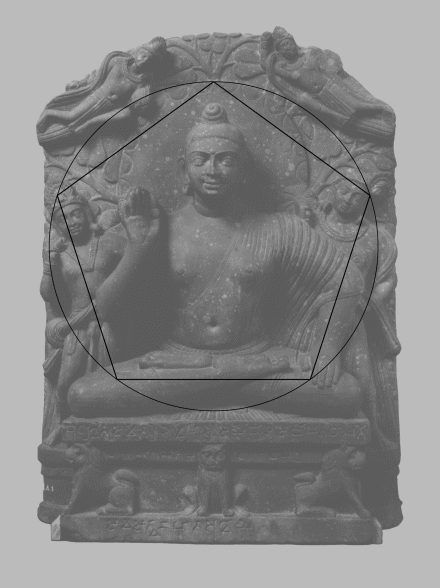
In 1993, Yagihashi Tsukasa had found that there were the important geometric
construction on some early Mathura buddhism sculptures. That essence is
very simple and skillful. Artists in Mathura who had begun to make sculptures
of Buddha were real masters. They had built up the fundamental concept
spread as a important vision of Mahayana-buddhism from this age.
From 1995 to 1999, Yagihashi had written 3 articles to explain about the
real and the concept of Mathura art. Artists of Mathura had been knowing
the most essential geometric shape. It is a rational form constructed by
8circles on geometry. Yagihashi had called this fantastic form The Shape
of Flower.
The 3 articles had been published by the art magazine [ars] from Tohoku
university of art and design in Japan. This web site will introduce the
outline of the articles.
花のかたち(1) 初期マトゥラー仏の構造と華厳思想
(1995年/東北芸術工科大学発行 ars誌3号)
The Shape of Flower (1)
The Construction of Early Mathura Buddha Sculptures
and The Idea of Buddhavatamsaka
1995/published by the art magazine [ars No.3]
from Tohoku university of art and design in Japan
Text-site(only Japanese) http://jam.velvet.jp/mathura-buddha.html
Pentagram of Mathura Museum A1 Sitting Buddha
On beginning of this study, Yagihashi had understood that this sculpture
had been designed from the gauge of pentagram. This plan is faultless and
the skill for making up is very correct. It is clear that the artist intend
to put monumental signs on vertexes of pentagon, (root of linden, head
decorations of two followers, top of finger).

PDF
The Shape of Flower
Next Yagihashi had understood that the gauge for this sculpture is more
fantastic thing. It is a very beautiful form constructed by only 8circles.
This arrangement of circles is pure geometric relation. Center points of
outside large 5circles are vertexes of pentagon. And the formation of inner
somewhat small 3circls is the method for tracing a equilateral triangle.
This shape is like a image of flower.

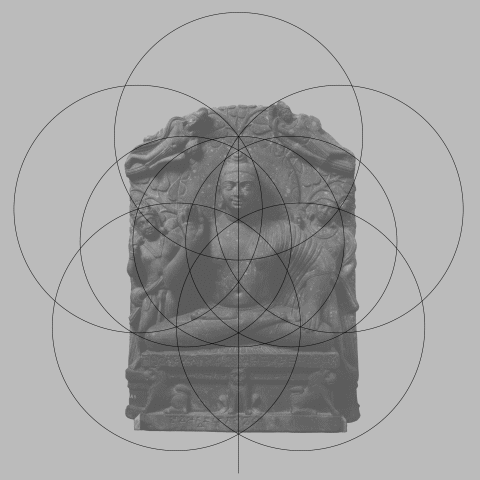
PDF
The Method to Chain Second Unit of The Shape of flower
Yagihashi had understood that Mathura masters had been knowing the method
to chain this gauge while diminished it by a especial ratio. This diagram
will be drawn by superimposition of the same unit diminished. Two units
must pile up connecting at each center upper vertex of pentagon. When doing
this operation, the second unit must diminish to be the next state. One
especial cross-point of circles on center line will connect up another
especial cross-point of first unit. This connected point is on throat of
Buddha. The center circle of second unit is according the circle of halo
of sculpture.
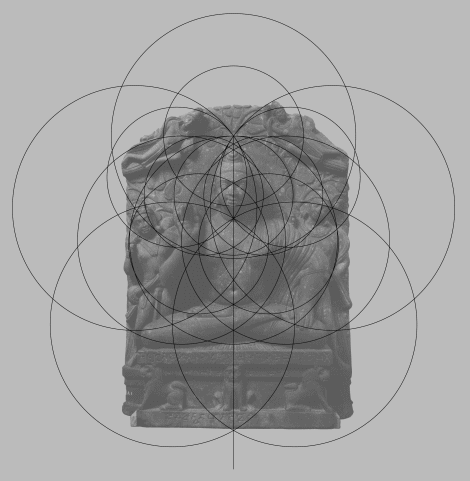
PDF 3step-unit PDF
More detaild explanation developing in 2011 for this sculpture and concern.
Sitting Buddha Mathura-A1
Standing Buddha Mathura-school in Gupta-age excavated in Jamalpur (mathura-A5/ 5th India)
Horyuji Sitting Buddha Asuka-age Japan 7-century
Celtic Disk of Metropolitan Museum and Ancient Chinese mirror in Han-age
/Coordination of Construction
Matrix
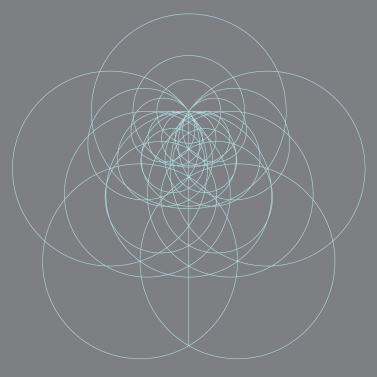
Explanation of the matrix system
The Infinite Chain of Shapes of Flower
We can repeat the same process many times. This idea will lead us the matter
of infinity and the concept of zero. When we draw this diagram, we are
regarding the center upper vertex of pentagon as the zero point. The zero
point is on the top of halo, the root of linden. This point seems to mean
Nirvana (enlightenment of Buddha). Yagihashi is thinking that the spiral
head top of this Bodhisattva is meaning his final movement to reach Nirvana.
Now he has become almost being as Buddha.
If we repeat this diminishing drawing, we can see a fantastic space as
perspective. Yagihashi is thinking this image of infinity space from an
artistic practice concerns the idea of the infinity world the Buddhavatamsaka
sutra (important mahayana-buddhism text) expresses.
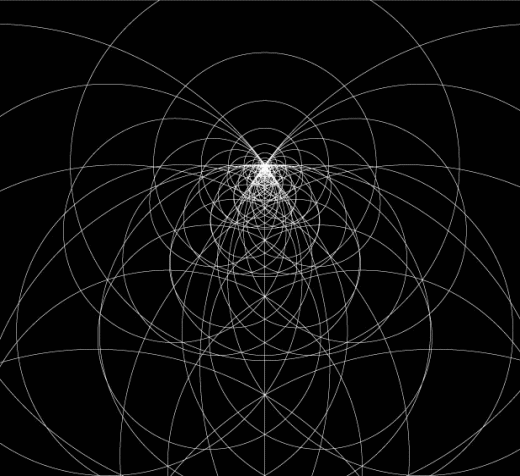
The Infinite Chain of Hexagon
The next one fractal construction is meaning purely the especial property
of equilateral hexagons and triangles. We will consider about the matter
of infinity and zero from this view as well.

The Infinite Chain of Hexagon on Sarnath Museum Standing Buddha
This standing Buddha sculpture had been designed from The Infinite Chain
of Hexagon. Today the top part of especial head of Buddha has lost. Now
we can imagine the original figure from this analysing photo. Yagihashi
is thinking this zero point of infinite chain must mean nirvana. Since
this Bodhisattva has come to this nirvana point closely, he has become
like the same as being of Buddha. This idea seems to be the real concept
for making up sculptures of Buddha.

花のかたち(2) 仏塔と胎蔵
(1996年/東北芸術工科大学発行 ars誌4号)
The Shape of Flower (2) Stupa and Garbha
1996/published by the art magazine [ars No.4]
from Tohoku university of art and design in Japan
Reliefs of Stupa in BC Age Not Being Buddha Sculpture
We can see prototypes of early Mathura concept on circle reliefs of BC
stupa age. Since artists in stupa age had used very straightly only one
unit of The Shape of Flower, we can understand easily their concept for
design.
 perfect accord with the gauge |
 . |
 curve of Naga by the gauge |
 . |
 . |
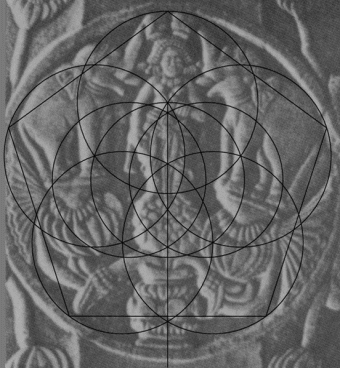 . |
花のかたち(3) マトゥラー造形理念の展開、そして東へ
(1999年/東北芸術工科大学発行 ars誌5号)
The Shape of Flower (3)
Evolution of Mathura Sculpture Concept, and going to East
1999/published by the art magazine [ars No.5]
from Tohoku university of art and design in Japan
Yagihashi had confirmed that the idea of Mathura had followed as the root
for making up sculpture of Buddha. Many important Buddha sculptures in
Gupta age had been made from the gauge of Shape of Flower. Gupta masters
had developed their new method from this root. It is very clever and amazing.
And this stream went to Japan exactly. Yagihashi had explained it in this
third article.
Sitting Buddha of Sarnath school in Gupta Age
This sculpture is a good example to know easily that Gupta-masters had
been useing the same gauge. This gauge is made from two units by the former
explained method. We can see the state that 2circles of the gauge are according
perfectly to 2circles of the halo of sculpture.
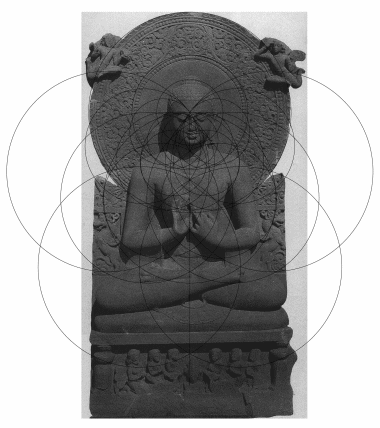
PDF
Standing Buddha Mathura-school in Gupta-age
excavated in Jamalpur (mathura-A5/ 5th India)
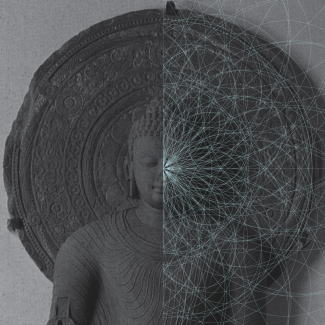
Standing Buddha Mathura-school in Gupta-age/ excavated in Jamalpur (mathura-A5/
5th India)
The construction of the halo corresponding with 16-radial matrix
Historical total development
The Consecutive Constructive theory of Buddhism
Arts and Ancient Mirrors
The explanation to the constructive theory of buddhism sculptures that
the early Mathura school shows, the Progressive step in the gupta mathura
school and Asuka sculptures Japan and Vajrayana Mandala Tibet. The origin
of this theory is found in wide Eurasia area before Mahayana.
Construction of Ancient disks
Celtic Disk of Metropolitan Museum and Ancient Chinese mirror in Han-age
Ras-shamra disks (Syria BC14^13th)
More reports
Construction of Mathura Buddhism Sculpture in Gupta Age
The scueeded Mathura theory to Asuka buddha sculptures in
Horyuji
Construction of ancient mirrors of China and Japan
The 3 articles introduced in this site had been performed by Yagihashi
Tsukasa and Jabrec Art Music from 1995 to 1999.
Developing investigation in 2011.
Inquiry to this work
Contact us